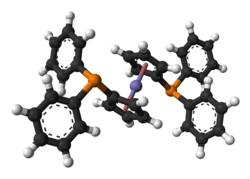1,1'-Bis(diphenylphosphino)ferrocene

| |

| |
| Names | |
|---|---|
| Preferred IUPAC name
(Ferrocene-1,1′-diyl)bis(diphenylphosphane) | |
| Other names
1,1′-Bis(diphenylphosphino)ferrocene, 1,1′-ferrocenediylbis(diphenylphosphine), Dppf, 1,1′-ferrocenebis(diphenylphosphine), 1,1′-bis(diphenylphosphanyl)ferrocene
| |
| Identifiers | |
3D model (JSmol)
|
|
| ChEBI | |
| ChemSpider | |
| ECHA InfoCard | 100.167.773 |
| EC Number |
|
| 24075 | |
PubChem CID
|
|
| UNII | |
CompTox Dashboard (EPA)
|
|
| |
| |
| Properties | |
| C34H28FeP2 | |
| Molar mass | 554.391 |
| Melting point | 181 to 183 °C (358 to 361 °F; 454 to 456 K) |
| Hazards | |
| Occupational safety and health (OHS/OSH): | |
Main hazards
|
Toxic |
| GHS labelling: | |
 
| |
| Warning | |
| H302, H312, H315, H319, H332 | |
Except where otherwise noted, data are given for materials in their standard state (at 25 °C [77 °F], 100 kPa).
| |
1,1′-Bis(diphenylphosphino)ferrocene, commonly abbreviated dppf, is an organophosphorus compound commonly used as a ligand in homogeneous catalysis. It contains a ferrocene moiety in its backbone, and is related to other bridged diphosphines such as 1,2-bis(diphenylphosphino)ethane (dppe).
Preparation
[edit]This compound is commercially available. It may be prepared by treating dilithioferrocene with chlorodiphenylphosphine:[1]
- Fe(C5H4Li)2 + 2 ClPPh2 → Fe(C5H4PPh2)2 + 2 LiCl
The dilithiation of ferrocene is easily achieved with n-butyllithium in the presence of TMEDA. Many related ligands can be made in this way. The Fe center is typically not involved in the behavior of the ligand.
Reactions
[edit]Dppf readily forms metal complexes.[2] The palladium derivative, (dppf)PdCl2, which is popular for palladium-catalyzed coupling reactions, is prepared by treating dppf with the acetonitrile or benzonitrile adducts of palladium dichloride:[2] Substitution of the phenyl substituents in dppf leads to derivatives with modified donor-acceptor properties at the phosphorus atoms.[3]
- dppf + PdCl2(RCN)2 → (dppf)PdCl2 + 2 RCN (RCN = acetonitrile or benzonitrile)

Another example of dppf in homogeneous catalysis is provided by the air- and moisture-stable Ni(II) precatalyst [(dppf)Ni(cinnamyl)Cl. It promotes Suzuki-Miyuara cross-coupling of heteroaryl boronic acids with nitrogen- and sulfur-containing heteroaryl halides.[4]

Another dppf-based catalyst is (dppf)Ni(o-tolyl)Cl, can be prepared from ligand exchange with (PPh3)2Ni(o-tolyl)Cl. It promotes the amination of aryl chlorides, sulfamates, mesylates, and triflates.[5]

See also
[edit]- Diphosphines
- borrowing hydrogen catalysis
References
[edit]- ^ Ian R. Butler (2010). "3.15 The Use of Organolithium Reagents in the Preparation of Ferrocene Derivatives" (Google Books excerpt). In J. Derek Woollins (ed.). Inorganic Experiments. John Wiley & Sons. pp. 175–179. ISBN 978-3-527-32472-9.
- ^ a b Nataro, Chip; Fosbenner, Stephanie M. (2009). "Synthesis and Characterization of Transition-Metal Complexes Containing 1,1′-Bis(diphenylphosphino)ferrocene". J. Chem. Educ. 86 (12): 1412. Bibcode:2009JChEd..86.1412N. doi:10.1021/ed086p1412.
- ^ Dey, Subhayan; Pietschnig, Rudolf (2021). "Chemistry of sterically demanding dppf-analogs". Coord. Chem. Rev. 437: 213850. doi:10.1016/j.ccr.2021.213850.
- ^ Ge, Shaozhong; Hartwig, John F. (2012-12-14). "Highly Reactive, Single-Component Nickel Catalyst Precursor for Suzuki–Miyuara Cross-Coupling of Heteroaryl Boronic Acids with Heteroaryl Halides". Angewandte Chemie International Edition. 51 (51): 12837–12841. doi:10.1002/anie.201207428. PMC 3613336. PMID 23136047.
- ^ Park, Nathaniel H.; Teverovskiy, Georgiy; Buchwald, Stephen L. (2014-01-03). "Development of an Air-Stable Nickel Precatalyst for the Amination of Aryl Chlorides, Sulfamates, Mesylates, and Triflates". Organic Letters. 16 (1): 220–223. doi:10.1021/ol403209k. PMC 3926134. PMID 24283652.
